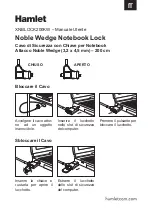
62
Disc Care
When handling optical discs, keep the following guidelines in mind.
•
Hold optical discs by the outer edge and the inner hub to avoid damaging the surface.
Avoid direct contact with the disc's surface.
•
Avoid scratching or soiling both sides of the disc.
•
Do not write on or apply labels to either side of the disc. Never write with a ballpoint on
the surface of the disc.
•
Do not use stickers, labels or write on both sides of a disc. Unless you use specific label
kits, never use a tape or sticky material to label optical discs. Since the data layer of a
disk is right beneath the printed label, writing with a pen can scratch the thin reflective
aluminium coating. Use soft-tip pens especially for re-writable disks that are even more
sensitive.
•
Do not scratch or polish the label side. The pits and lands (microscopic holes and flat
areas) that encode the information in the CD are on the label side, and not on the surface
read by the lens. Large scratches on the underside, however, can often be repaired using
special polishing kits. Most of the time, the laser, which focuses on a layer within the
clear base, is able to see past small scratches, in much the same way the human eye can
focus on objects outside when looking through a window.
•
Keep the disc away from direct sunlight, high temperatures, and humidity.
•
Keep optical discs away from high temperatures. Don't subject disks at temperature
levels exceeding 37°C. Exposure to direct sunlight over long periods easily warps a disk.
Low temperatures are not a hazard, but wait for a stable temperature before loading a
disk. Disks burned using CD-writer drives are more sensitive and should be stored at
room temperature whenever possible.
•
Moisture does not affect other types of discs, but avoid exposing re-writable disks to
liquids. In case of accidental spills on discs, rinse it off with lukewarm water and wipe dry
with a soft cloth. Be careful with sticky or oily substances that trap dirt and dust.
•
Proper cleaning is important to achieve optimal performance. Using a soft, slightly damp
cloth, wipe the disc from inside the disk and rub outwards. Do not wipe in circles but
clean in the same outward direction. Wiping the label side in circles can scratch a section
of the data track. Slightly dipping the cloth in warm water is enough. Using cleaners and
solvents can do damage.
Caution
Since discs are coated with thin layers of aluminium and plastic, avoid using benzene, paint
thinner, record cleaner, static repellent, or any other chemical to clean the disc. Chemicals and
cleaners can damage the disc.
Optical Disc Drive Care
To get the most from your optical disc drive, keep the following guidelines in mind.
•
Never forcibly pry open a drive whenever a disc gets stuck. The plastic tray is a relatively
fragile and vulnerable mechanism. Loading a CD off-centre is a common mistake that can
jam the tray. If this happens use the eject button, or the emergency eject hole. If that
fails, ask for professional help.
•
Avoid excessive dirt and dust build-up on optical discs. Optical discs can tolerate
accumulated dirt and dust much better than floppy disks since CDs are not read by direct
contact with the read lens. Excessive dirt, however, will eventually affect the drive's
performance. Thoroughly clean the discs whenever necessary.
















































